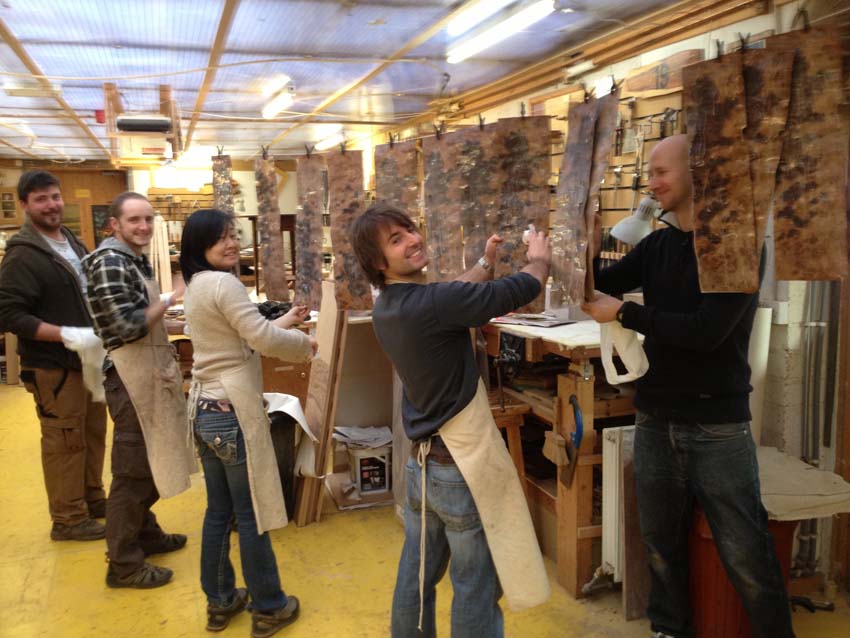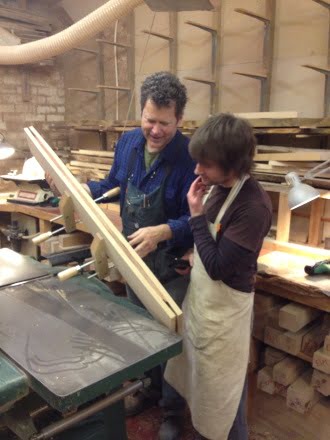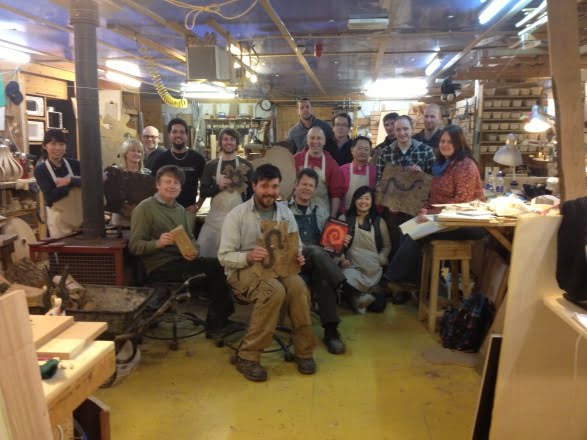Scott Grove, an award-winning New York artist, sculptor and woodworker, delivered an inspiring, week long veneering course to last year’s students at the Chippendale International School of Furniture near Edinburgh. This was his first ever course at a UK furniture making school and he’s coming back to teach this year’s students. This is the blog about his visit to the furniture school.
When I was asked to teach at The Chippendale International School of Furniture in Scotland, I jumped at the chance but wasn’t sure exactly what I was getting myself into. As it turned out, neither did they. It was a mutual gamble taken by both parties that yielded a great experience and exchange of knowledge. And the scotch and ale was pretty good too.
The Chippendale School offers a complete and diverse curriculum and brings in various experts to teach specialized skill sets. Travelling to the United Kingdom to introduce my pioneered veneering techniques was certainly an honor, but I wondered, would they be open to such innovative and unconventional practices? Would I even be able to understand what they were saying through their Scottish brogue?

I assumed the school would be a conventional learning center with old school methods, and getting traditional woodworkers to think outside the box could be a challenge. In any event, I was going to take a leap of faith and give it my best shot –to my surprise I discovered how progressive they are across the pond.
In fact, it is in “a leap of faith” that keeps The Chippendale School ahead of the curve. Anselm Fraser, current owner and principal of the School, openly admits one has to take risks every day to learn anything. Success or failure, he and his students are always learning. His mantra: If you don’t push your limits you won’t know how far you can go.
When I heard him say this while he introduced me to his students on the first day, I knew I was in the right place. One of my own sayings is “find the line and cross it, move it, and cross it again.”
Anselm openly admitted that he was taking a chance by bringing me over from America but had a hunch this would be good for the students at the school. It turned out to be a great idea for everyone.

The Chippendale School’s intensive woodworking program lasts for 30 weeks. Each student is required to complete three major works, a number of smaller projects along with a display box chock full of samples that demonstrate various materials and techniques they have mastered at the school. In addition, they formulate realistic future business and marketing plans for the path that lies ahead of them.
The School is situated in a circa-1820 stone farmstead just outside the small village of Gifford, about half an hour east of Edinburgh, the capital of Scotland, which is a wonderful historic city with plenty of historic sights to see and scotch and ale to taste.
The Chippendale School is set in a beautiful location with all the charm one can imagine. Abandoned castles are off in the distance, and the whitest sheep graze on the greenest grass I’ve ever seen. Add the rolling misty hills and rare glimpses of a precious glowing orb in the sky, and it was absolutely stunning and very inspirational.

The grounds have all sorts of fun and creative landscaping details. You can even take a hot tub soak in a couple of old claw-foot tub outdoors, overlooking the fields of grazing sheep. You just have to light the fire under the tub first. The building is heated with wood stoves and walk-in fireplaces for the entire facility, and the morning chill seemed appropriate to get one moving. We often huddled around the fire with ginger tea while reviewing the day’s tasks.
There were 20 students from all over the world: South Korea, Malaysia, Mexico, New Zealand, Japan, Canada, and the UK. Some had no previous experience in woodworking and were changing careers midlife; others wanted to hone their current skills and were ready to start a career. When I showed up they were halfway through, 15 weeks in. They had already produced one of their major projects and were well on the way to their second. These projects were not your typical side boards, coffee tables and demi-lunes. They varied in design, materials, and method of construction as much as the students’ ethnic backgrounds. Frankly I was blown away by how ambitious and daring these projects were.
I’ve had the pleasure of visiting many design and craft schools in the States, from major universities to private schools, and these projects were graduate-level pieces and beyond. They were also designed and fabricated in an amazingly condensed time frame. How could this be? I asked myself. I thought I must be missing something. I then remembered my first introduction: they take risks every day.
As the week went on, besides attending my demonstrations and producing my daily project challenges with exceptional creative vitality, the students continued working on their second major project with a deadline and formal critique forthcoming.
Besides the cultural diversity that spawns creative juices and technical solutions, the school also maintains a side furniture restoration and furniture making business with various projects simultaneously being performed. Staffed by skilled woodworkers who double as class tutors, this group would lead impromptu demos and conversations would take place unrelated to the day’s curriculum, such as applying leather to a flip top desk or water gilding an accent finial. They would point out issues they had with a piece and discuss options on how to fix, restore and refinish it.

In addition to the restoration business, the school rents out 10 benches in another side of the shop (known as the Chippendale Incubation Workshops) which adds to the everyday reality of the woodworking business experience. Woodworkers by nature like to share tips and tricks, and the cross pollination and real world practices was refreshing.
I don’t think Anselm sleeps much. He is your typical wiry Scotsman with plenty of energy and ideas. Not only does he teach his students woodworking skills, he helps them become successful woodworker businesspeople. Each day he meets with a student over a private lunch for a one-to-one discussion on future plans and connects students with various contacts he has all over the world. He encouraged me to chime in (not that I needed much encouragement) and I added my business and marketing anecdotes during lunch too.
Scott Grove’s story will be continued in his next blog….
